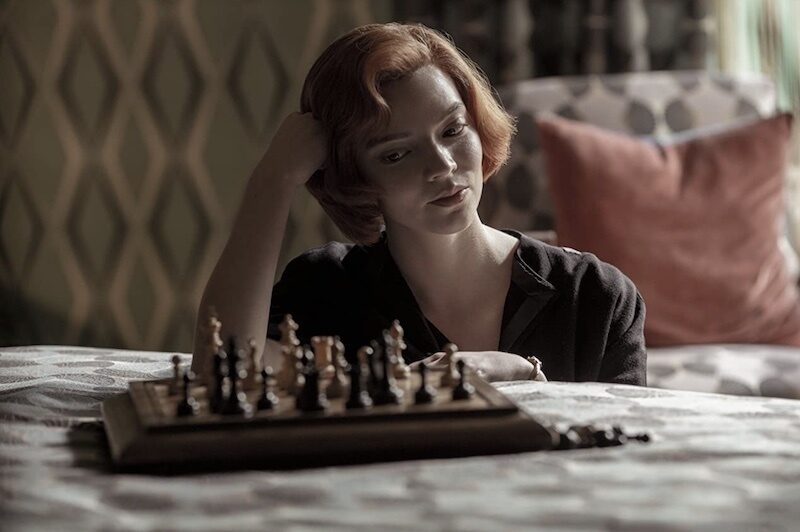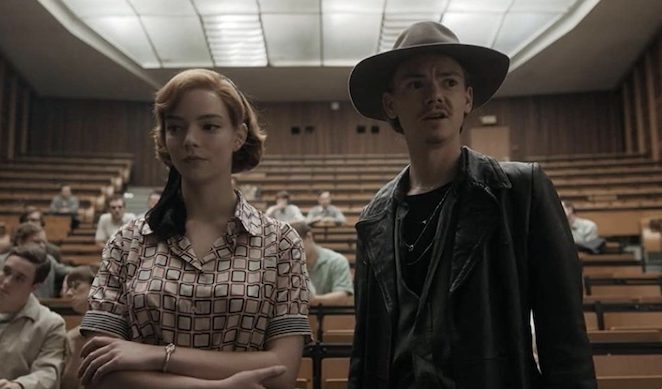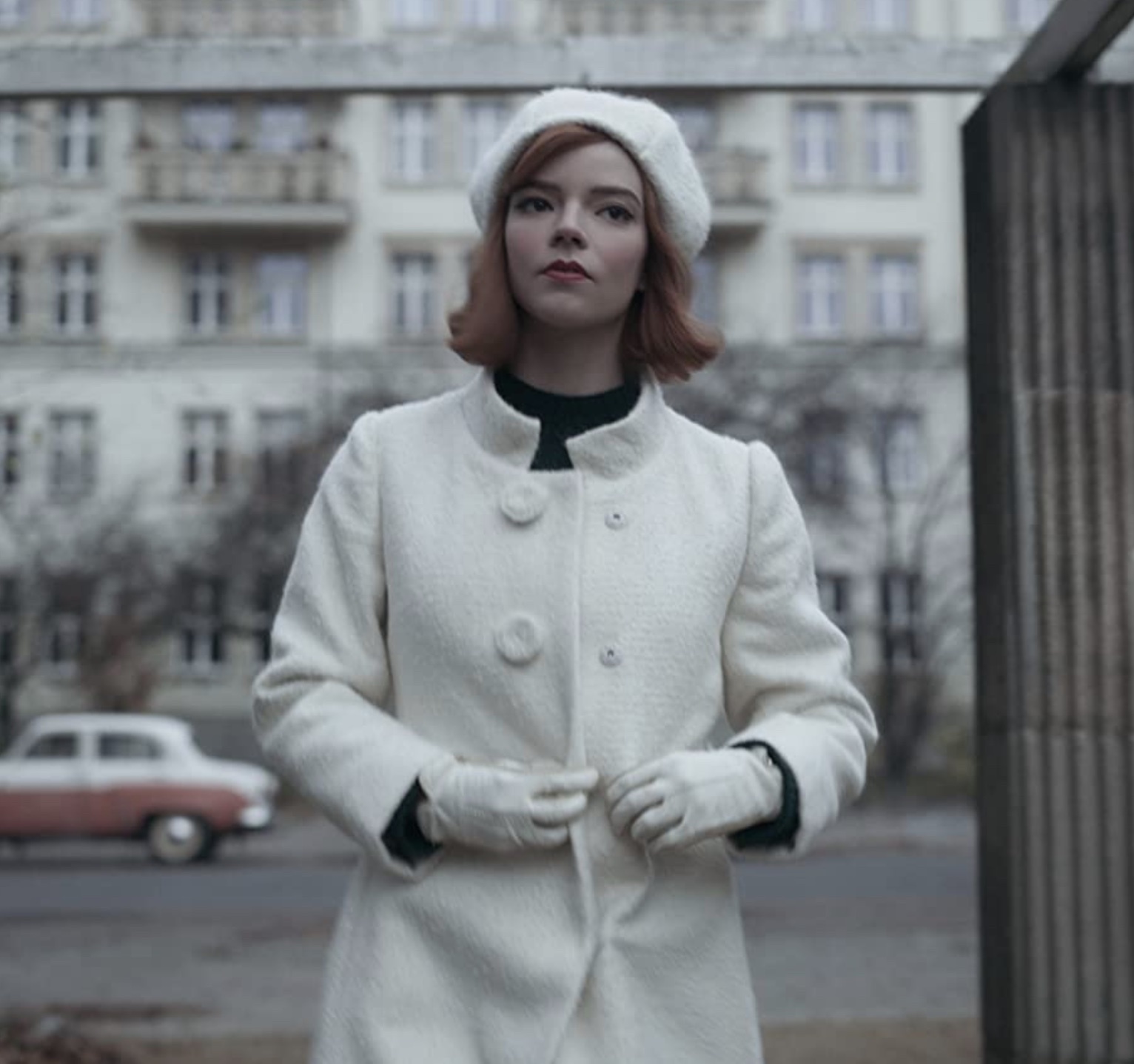Cinematography and Fashion Redeem The Queen’s Gambit
Review of The Queen’s Gambit
Written collectively by the Teen Editorial Staff

The Teen Editorial Staff teamed up to write mini-reviews of the popular Netflix show The Queen’s Gambit. Read on to enjoy these six different perspectives on what worked, what didn’t, and why it might still be worth a watch.
Triona
The Queen’s Gambit on Netflix follows chess prodigy, Beth Harmon, as she navigates both the world of competitive chess and the general struggles of transitioning from adolescence to adulthood. Though some of Beth’s hardships feel simplified—no one gets over a lifelong drug addiction by just deciding to—the story is captivating nonetheless.
One thing that stands out to me is how human the characters seem. The people who act out of self-interest once are often the same people who act out of charity later, or vice versa. Beth’s adoptive mother Alma initially encourages Beth’s chess competitions because she sees them as a way to make money. I’ll admit, I was concerned that Alma was planning to manipulate Beth to get the money for herself, but she quickly proves to be supportive in her intentions. Is she still using Beth, to an extent? Yes. But Beth is using Alma, too. They take care of each other, and though they don’t always make good decisions, they trust each other enough to maintain that happy little gray area of a mutually beneficial relationship.
There are certainly things that The Queen’s Gambit struggles with, but a complex and interesting cast of characters who make realistic choices is not one of them.
Mila
After watching just the first episode of The Queen’s Gambit, I was already invested in the main character, Beth Harmon: a mousy orphan girl with an intense interest in—and aptitude for—playing chess. The show’s ability to suck in its viewers, including myself who has never understood much more than how chess pieces move, is rooted in the intentionality behind the cinematography that allows the viewer to go beyond merely observing the events Beth experiences, but to feel them right alongside her. This technique, while prevalent throughout the first episode, is abundant even from the start. The show opens to a black screen coupled with the sound of persistent knocking on a door. We are then shown Beth emerging from a bath, fully clothed, in an unlit room. We weren’t introduced to Beth with a shot of her submerged underwater; rather, we experience the sensory deprivation alongside her, only beginning to see the scene when she is likewise out of the water and able to see. Beth then hurriedly makes herself presentable in a luxurious apartment littered with the hallmarks of a rough night, to say the least: drugs, alcohol, and an unknown figure still in bed. The viewer is only alerted to the person’s presence after a soft moan is heard, and Beth herself directs her gaze towards them. We experience things as Beth does. And as she rushes to the chess meet, we, the viewers, are stunned by flashes of light before being shown the source: cameras going off in Beth’s face.
The details of each scene bring Beth’s character to life, so when we get to the climax, even though the drama revolves around a very niche activity, we are invested in it because we are invested in Beth.

Lucia
For a show centered around high-action games of chess, each scene of The Queen’s Gambit does a masterful job in keeping its viewers on edge. What may seem mundane on paper—an adoption scene, a dispute between a married couple—complements specific but effective filmography and writing techniques to set the pace. One good example of this is, oddly enough, negative space. Take the stilted, few words of Beth’s adoptive father, for example. What characters don’t say or do reflects more about their personality than what they do, which is a useful engagement tactic. The show’s format forces the audience to actively make judgments about a person instead of being spoon-fed lines. This artistic decision may well be a saving grace for The Queen’s Gambit, for it is in an over-saturated media market filled with repetitive plots and premises, falling victim to a variety of tired tropes.
Lily
Little more than a mild revision of a tired trope, The Queen's Gambit re-tells the story of the tortured genius. Although the protagonist, sharp-witted chess savant Beth Harmon (played by a superb Anya Taylor-Joy) may be unlike other recent caricatures in that she is a woman, her story is nothing new. Following in the footsteps of others, The Queen's Gambit attempts to craft its own explanation for why massive intelligence must equal social isolation. Throughout the series, Beth is always left wondering what's next for her after she grasps her newest accomplishment. But, she's too troubled by memories of her orphan past to ever slow down, and, after her mother dies, has little support left other than the drugs she takes to enhance her chess skills. Naturally, she finds new meaning in old friends, once she stops shutting them out.
Although The Queen's Gambit may falter in plot, it almost makes up for it in sheer production quality. The gorgeous costuming, stellar camera shots, and ingenious sound design make the series still worth a watch. The competition scenes especially are crafted intricately and expertly build up suspense. I don't think I've ever been enthralled in a chess match, but the tick-tick of the clock, the subtle click of the pieces, and the intensity on Taylor-Joy's face as she made her moves had me on the edge of my seat.

Eleanor
If everything I knew about women I learned from books and film, I would think that all women can be divided into one of two categories: those who do not care about clothes and makeup, and those who are implied to be vain and shallow because they care about clothes and makeup. From a story perspective, The Queen’s Gambit and its strict adherence to the tortured genius trope brings nothing new. Yet, what The Queen’s Gambit does present is an idea seldom explored on screen: that women can derive power, comfort, and confidence from their clothing.
There is something so uniquely honest about the way Beth, the anomalous female chess prodigy finds strength in her clothing that I have not seen in television or film. When Beth and Alma (Beth’s adoptive mother) go shopping after Beth’s first chess meet, Beth admires a dress displayed on one of the mannequins, and though there is not a scene where Beth buys the dress, she wears it throughout the rest of the series. This theme is so satisfying because it does not try to make a point about Beth’s fondness for clothing; it just is. There is no hint of the director seeking to sexualize Beth or some external force influencing the way she presents herself. Instead, Beth dresses for herself because she knows what she likes. So, although the story is tired, it is refreshing to see a woman like clothes without the story making a point about how she is vain or trying to impress someone else.
Anya
There’s something about the way that Beth Harmon (Anya Taylor-Joy) carries herself—the loose swing of her hands as she walks, the sharp way she moves a queen across a chess board—that makes me want to sit up straighter. I admire her composure, almost bordering on haughtiness, as she handily beats boy after boy, then (as she grows older) man after man at chess tournaments around the world. It is true that the trope of a precocious young child with a lack of emotional awareness has been trotted out all too frequently. But in the case of Beth, where a stereotype is played to perfection—I can feel her awkwardness as she avoids acknowledging a love confession and smirk as she reads a chess book after growing intimate with a partner—I’m willing to let it slide.
Lead photo credit: Anya Taylor-Joy in The Queen’s Gambit (2020). Photo courtesy of Netflix © 2020 Netflix, Inc.
The TeenTix Newsroom is a group of teen writers led by the Teen Editorial Staff. For each review, Newsroom writers work individually with a teen editor to polish their writing for publication. The Teen Editorial Staff is made up of 6 teens who curate the review portion of the TeenTix blog. More information about the Teen Editorial Staff can be found HERE.
The TeenTix Press Corps promotes critical thinking, communication, and information literacy through criticism and journalism practice for teens. For more information about the Press Corps program see HERE.


